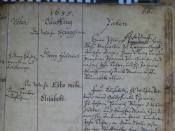Peter Sculthorpe's Port Essington
String Techniques & Variation Form
One of the main differences between Peter Sculthorpe's compositions and that of other composers is that he uses a variety of string techniques to create different sounds throughout his music. He uses a mixture of string techniques in 'Port Essington' to represent the harsh Australian climate. He has created different notation to represent these new techniques. A list of the notation and how the sound is played follows:-
It is played between the bridge and tailpiece. It sounds like a harmonic.
Any very high note.
Gliss upwards from any very high note.
Gliss downwards from any very high note.
Rub bow along strings. Give a very soft whispering sound.
Quarter tone trill. Sound is produces by creating a very slow and wide vibrato.
Is another example of harmonics. The sound is produced by lightly touching the string with your left finger and bow while moving your left hand.
Another piece of music notation that Peter Sculthorpe incorporates in his compositions is the word 'liberamente'. It means 'freely'; don't play in time with your neighbours.
When a piece of music is composed, the theme is usually borrowed from another piece. The reason we do not pick it easily by ear is that it has been altered in some way. This includes other notes being added, the rhythm is changed (crotchets, minims etc) or the key changed.
In the case of 'Port Essington', the theme is an Aboriginal tune called 'Djillie'. The tune was collected by Prof. A.P. Elkin. This tune is varied throughout the piece in each movement. In movement six, the melody played by violin 1 is closest to the original tune.
The theme variations are as follows in each movement:-
Movement 1- In a Peter Sculthorpe style a...


